One of the most common things I’m asked is, “Does it matter what order I apply my moisturisers in?” Another is, “Why do you say mineral oil is a good moisturiser when it doesn’t contain anything that’s good for your skin?” The answer to both these questions lies in the concept of layering.
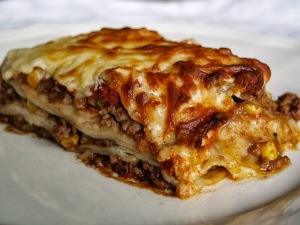 |
| The best type of layering. (Picture credit: Elin B) |
First, a reminder about moisturising – it’s all about putting water back into your skin. There are three main types of moisturisers I’ve mentioned before in more detail – briefly, we have:
Occlusives – these are greasy oils that block water from evaporating. Common examples are petroleum jelly, mineral oil (both super effective), lanolin, silicones (e.g. dimethicone), olive oil, carnauba wax, and beeswax.
Humectants – these are water-attracting molecules which grab hold of water and slow down its evaporation. Examples are glycerin/glycerol, hyaluronic acid, propylene glycol, sorbitol, pathenol, and honey.
Emollients – these lighter oils sink into the skin and replace natural skin oils, helping to bind the skin cells back together into a nice solid layer, which feels soft and smooth to the touch. Examples include silicones, isopropyl palmitate, jojoba oil, propylene glycol, and vitamin E.
You can find more examples of each of these ingredients in the original article. As you can see, some ingredients can do more than one thing.
The main scientific concept that’s at play here is that oil repels water. You know how when you put oil and water together, the oil and water don’t mix, and when you put a greasy spoon into plain water, you can’t scrub the grease off without adding soap? This is exactly how layering works!
The other thing to remember is that water evaporates, but oils don’t.
Enter… layering!
Option 1:
So say you put an oil-only moisturiser (which would have emollient or occlusive actions) directly on dry, thirsty skin, then top it with a water-based moisturiser (which probably contains some humectants). What happens is that the oil stops the water from getting through to the skin, and even though some of the emollient oils may sink into the skin and make it softer, there’s minimal water reaching your skin before it evaporates. Your moisturiser is actually not doing much moisturising at all!
However, your body is full of water, so this will still prevent water from evaporating through your skin. But it does mean that it’ll take a lot longer for the water to rise through your skin and build up in the upper layers that need hydration. It’s not necessarily that bad, but also won’t give any immediate relief.
Option 2:
Now what happens when you do the reverse, and apply watery moisturiser first, then top with an oil-based moisturiser? This time, the water is right next to your skin, and the oil actually seals in the water so it has time to enter your skin. After the watery layer is mostly absorbed, the emollient oils will do their job and the occlusive oils keep the whole shebang in your soft, hydrated skin.
So even though mineral oil might not directly contain anything “good for your skin”, it’s excellent at trapping water next to your skin for absorption.
Does it really matter?
In reality, most moisturisers you buy will have water as a main ingredient, so you won’t fall into the trap of doing Option 1 and not-moisturising with your moisturiser (it’s not just there to make it cheaper to produce!). Most moisturisers will also have a blend of all three types of moisturiser, so you don’t have to think too much about layering, as all three will reach your skin. Additionally, the rubbing-in action will make the layers less distinct.
However, if you use any pure oils in your routine (e.g. rosehip, coconut, olive, mineral oil (aka baby oil or Bio-Oil)) or thick, water-free body butters, then keep in mind that to actually add moisture to your skin quickly, you’ll need to let water reach your skin somehow.
The most effective order of layering then, if you want maximum moisturisation, would be:
– Immediately after a shower (when your skin is still damp with water)
– Apply a humectant-rich moisturiser
– Add an emollient-based moisturiser
– Seal it all in with an occlusive oil.
Applying your moisturisers immediately after a shower (or even in the shower) will trap water next to your skin – think of it as a free moisture boost!
What about treatments?
As you might expect, it seems sensible to apply treatments and serums as close to your skin as possible, so they’re not diluted down by the time they reach your skin…but what if you have two treatments? What order do you apply those in?
Again, it’s down to water – the most effective option if you want to play it safe would be water-soluble ingredients first, oil-based ingredients second. An easy-to-remember rule of thumb is to apply the water-based serums first before the oily treatments, and to wait in between applying different treatments. Then after the treatments are on, you can slather on your plain-Jane moisturisers.
None of these are hard and fast rules – if you use a small amount of oil, it’s incredibly unlikely to interfere with absorption, and layers on your skin don’t stay intact for long, so most ingredients will eventually reach your skin. But these general rules of thumb should give your products the best chances of working as effectively as possible.
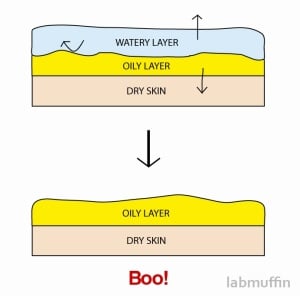
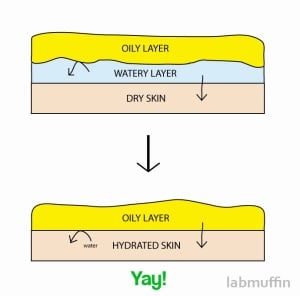


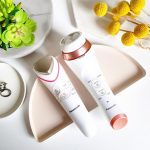
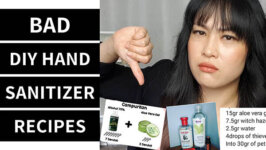
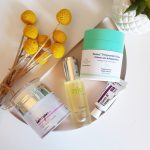
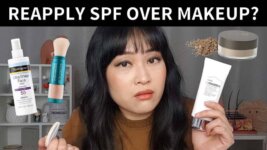
Hey Michelle – great post! I find that putting just rosehip oil (or any facial oil) is enough for my skin to stay hydrated. I’ve always been told that water is actually dehydrating to your skin – so I’m confused to why it’s best to apply moisturisers in the shower.. is it similar to that if you wash your hands with water a lot it can cause dryness? Do you know what I mean lol. Caroline Hirron says that sunscreen should go on last, no matter what you’re wearing – do you agree?
All I have to say is: I love Caroline Hirons. My skin is feeling so wonderful since I’ve started following some of her advice.
Jess
Mel – Lucky you! I can get away with just RHO on my face in summer, but in winter…Argh! And the rest of my body is just whiny.
Water is dehydrating because it washes away the oil (whether natural or from moisturisers) from your skin, which means you have less of an oily layer to keep the water in your skin. That’s why long hot showers are really bad for people with eczema – you can get most of the oil off an oily spoon by blasting it with hot water for a long time, but washing it gently with cold water won’t do much. It’s the same with skin, except you want it to stay oily.
For sunscreen – it really depends what sort of sunscreen. Some sunscreens – “chemical” sunscreens – actually need to sink into the skin to work, whereas others (“physical” sunscreens, which are also made of chemicals) simply sit on top of the skin. Another issue is that many sunscreens come in very occlusive-rich formulas, so applying them first may leave you doing Option 1. So it’s a tricky question with no easy answer! Putting it on last would be a good general rule, but if your sunscreen is built into a serum or a water-based moisturiser, you can probably put it on at the normal time in your routine.
Hello labmuffin!
Concerning sunscreen and oils…
I wash, hydrate and put on a oil (rosehip sort of oil mix)
I also use a physical (zinc 20%) sunscreen in form of cc cream.
To finish, my makeup is all RMS beauty which is basically coconut oils.
I’m concerned about this sequence. If I put make up before sunscreen the makeup glides off. If I put make up after sunscreen I’m afraid the oils of the makeup will affect the zinc protection.
What’s your advice?
Thank you
I
Check out this post: All Your Sunscreen and Makeup Questions Answered
Thanks Michelle! Also, does hair work the same as the skin? So if your hair is wet and you apply hair oil, it will hydrate it better? I put dry oil all over my body as soon as I stepped out of the shower and I’m feeling super hydrated (except I burnt my cheeks in the sun 🙁 )
It’s a similar concept for hair in that you should apply the stuff that sinks into the core of the hair before you apply stuff that coats the hair, but the list of stuff that sinks in/stays outside is different 🙂
Great post! My question about layering is for my anti blemish creams. Usually I put my moisturiser on and then my pimple cream on any spots. But sometimes I feel like the zit cream can’t get to the spots because it’s got the moisturiser in the way! So I’ll sometimes skip moisturiser in favour of zit cream going straight on to annihilate the spot. Is that stupid or clever?
I have the same question! I often feel like I should apply spot treatments first so they’re closest to the skin, but then when I apply my moisturiser I feel like I’m rubbing the cream off!
Zit cream first, wait 10-15 minutes then moisturise 🙂 This is also a good idea because zit cream usually contains benzoyl peroxide, which is pretty reactive – you don’t want it turning the stuff in your moisturiser (especially if it’s a moisturiser with natural ingredients) into god knows what!
I love these posts where you explain the science the behind beauty products or regimes (beauty and science are two of my favourite things!)
Would you consider doing a post on hyaluronic acid? I hear so many good things about it, and I adore my Hydraluron (on sale at priceline right now if you want to try it!), I want to understand more about how it work. You see claims everywhere saying something along the lines of ‘it holds 1000 times its weight in water’ and I don’t know quite how that works, or if its even true.
Thanks for the great post!
Jess xo
That’s a great idea for a post, thank you! 🙂
Michelle – you are my hero. Thank you for your amazing website and all the knowledge bombs you’re dropping on us.
A post about hyaluronic acid would be fantastic. There is so much conflicting information regarding this ingredient and I can’t help but wonder if this is just a “trendy” ingredient that when applied topically isn’t all that beneficial.
I love your blog
Thank you! 🙂
This is such a useful post! I have learned a lot from you. Thank you!
Glad you liked it Anna 🙂
Wow really helpful! I was actually doing the opposite recently – rosehip oil then my moisturiser! Thank goodness I read your post 🙂
Rose hip oil is actually a tricky one – if you’re using it for its brightening Vit A qualities then you want it concentrated so it goes on as a treatment, but if you’re using it purely to moisturise (with its awesome fatty acids) then it should go over the watery stuff. A good compromise is to apply it after a shower so there’s water next to your skin already 🙂
Another option, if you don’t shower before applying RHO, would be to use a spray first, I’ve been using Jurlique Rosewater Balancing Mist and Uriage Thermal Water for this. For a cheaper option, you could make your own water spray, or even just splash your face with water and blot it off first, to prevent the horrible “dry but oily skin” feeling.
Brilliant post – super helpful – thank you x
http://www.lippylikes.blogspot.com
You’re welcome, I’m glad it helped 🙂
Oh gosh, ew, combining moisturiser and lasagna!
Jennifer
http://naturewithnurture.blogspot.com
Great article Michelle!
This post was so interesting! It taught me a lot, thank you 🙂
I have just discovered your blog and love the clear explanations; it’s so rare to find proper explanations about beauty products with all the myths and claims around them!
I’m planning on using Kiehl’s Midninght Recovery Concentrate along with a moisturiser. In the case of MRC, might it be enough/better without moisturiser, and might it be more effective as a treatment under the moisturiser?
Can I use those after glycolic acid toner (like Pixi Glow Tonic)?
Thank you!
Thanks for such an informative and excellent post! What would one do if ones retina-a is vaseline based? (as it is in Sweden) but wish to use it in conjunction with face oils such as rose hip oil and jojoba oil . I have heard that tretinoin should be used on bare dry skin. but it might block the oils since the retin -a I have paraffin and vaselin are the third resp fourth ingredient after Cetomacrogol 100, and Cetearyl alcohol)
I am simply at loss. I guess at those tree night my main concern is that the tret will penetrate. Love my oils though 🙂
Best regards
/A
I think if your Retin-A is already blocking itself with the Vaseline, it should be OK to put a little bit of oil underneath!
Thank you! 🙂
I’ve just come across your blog and love it so far! Being a dietitian, I hate hate HATE misinformation and “marketing” lies on products and your page provides science and myth busting. Unfortunately I don’t want to fork up money to see a dermatologist for just regular skin care so your page is great! Science FTW!
I have a question – I use ego QV cream as a moisturiser but in the winter have found I need extra so have added rose hip oil to my routine. Which one should go on first? I’m using RHO for the moisterising effect… QV cream has parrafinum & glycerin as it’s next ingredients after water so it’s more occlusive??
Thank you!
That’s a tricky question, because ideally you’d want to go glycerin, rose hip oil, paraffinum… I’d just mix the two in the palm of my hand and apply for peace of mind but I’d expect that it doesn’t really matter.
Hi. I just found your blog and I’m addicted, i hate skincare BS and you save me research time that i dont have. This being said, what about silicone based products? For a silicone based serum for instance, i’m using it before my moisturiser (usually water based, but sometimes RHO), am I doing it right? Thanks in advance!
I prefer using silicone serums at the end because they tend to be quite occlusive. If you don’t use very much though, it should be fine!
I ADORE your blog! Recently chanced on it; it has demystified and enlightened me on sooo many fronts on skincare. Thank you thank you thank you! <3 Just to follow up on this excellent subject: where does pH level come in with regards to layering?
For example, if the rule is: low ph serums first, then medium-low ph exfoliants, then neutral ph retinoids, then water-based+emollient moisturiser, then occlusives, what do you do if all/most of your products contain silicones?
I'm finding it a struggle to formulate a routine where I incorporate a vitamin C serum (silicone free), a retinoid (with silicones), a BHA (with silicone), and a water based+emollient moisturiser (with silicones). Does the fact that they contain silicone render each ineffective as they won't penetrate through the former product? Many thanks in advance!
It’s controversial whether you should go from high to low pH or vice versa – there aren’t any studies on it, and I’ve seen arguments going both ways. Which retinoid is it? That will make a difference because some retinoids need neutral pH and some don’t.
Silicones won’t be occlusive if they’re not the main component of the product. If it feels waxy it might be a problem, but if not you can just ignore it.
Thanks that’s useful to know! It’s a retinaldehyde (specifically, Avene’s Ystheal range) and the strength is 0.015.
Just found this post, so helpful & informative! I wanted to ask about hyaluronic acid. I understand HA pulls water from the air into skin, but wouldn’t it not be able to do that if I put [rosehip/jojoba] oil over it? I have very dry skin so I want to hydrate it as much as possible, but I also don’t want to be wasteful. Thank you!
I’m wondering the same thing. If I wanted my HA to pull in the most water possible (I was planning to sleep with a humidifier near me) wouldn’t an occlusive at the top prevent that water from being sucked in?
It’s more effective to put the water on your skin and seal it in with an occlusive than to try to suck it in from the air afterwards – a water-based product would be 100% water, while in the air you can only really get 5% max (100% relative humidity is ~5% at 30 degrees C). Once the occlusive layer is leaky enough to leak significant water, it’ll also be leaky enough to let in some of the humidifier water 🙂
Hello!
Just wanted to let you know that I have linked to this in my latest blog post – hope that’s ok! Your blog is a brilliant resource and I especially love the science-based explanatory posts.
Melissa
Of course that’s OK! I’m very flattered 🙂
I use The Ordinary Granactive Retinoid 2% in Squalane, should I use it on bare skin because it is considered treatment? Or after my toner and water serums, because it contains Squalane? I am confused… Help me please 🙂
I would use it after toner and serums.
Is it possible to mix humectants with oils for skin? Or better to layer up? I layered before with first my humectant combo I made (Aloe Vera gel + hyaluronic acid base + glycerin) and then the oil combo, but my face was too oily..felt like the oil didn’t get absorbed and so it was sitting on my face. So I mixed my humectants with oils but then the result was that I was not moisturized enough. Please help!
A great, informative post! I have anecdotal examples of how people layer their skincare products, and had pieced together from a basic knowledge of the ingredients, but it is great to have everything broken down and confirmed 🙂
Quick question though. If you oil cleanse, will it mess with your water-based moisturizers. I typically double cleanse with with oils and a foaming cleanser, then follow with an exfoliant and then sometimes a serum before a water-based moisturizer and sometimes another oil to cap it off. Would the leftover oil from the oil cleanser make my moisturizer less effective. I generally assumed that most of that oil is taken away with the foam cleanser and the exfoliant buuutttt….
(On another note, since BHAs are oil-soluable and are usually in an oil-based base, will they cause problems when followed by a water-based moisturizer? So many tiny details….)
Your skin naturally has a lot of oils in and on it, so it isn’t really that big of an issue 🙂
Hi Michelle! Thank you so much for this post. A couple of questions:
What is a “dry” oil? I’ve seen it on the internet as an oil that sinks into skin better (as opposed to an occlusive that sits on top to retain water) – is that just another word for an emollient oil?
Is rosehip oil a humectant or occlusive? I use it in my routine and am trying to figure out it’s role in the whole process, and whether I should add a more emollient oil, like jojoba or a better occlusive
I have extremely dry, eczema prone skin. On my face I use a water, HA serum, HA moisturizer, rosehip oil & on my body I use water & mineral oil. I still find my face is a bit dry after all of that. Do I need a better occlusive than rosehip oil?
Dear Michelle,
Thank you for this post!
I am sorry if my question is silly, but I am a newbie in skin care.
If I want to do layering, should I wait while the previous layer dry up/soak in, or not?
Bests,
Katja